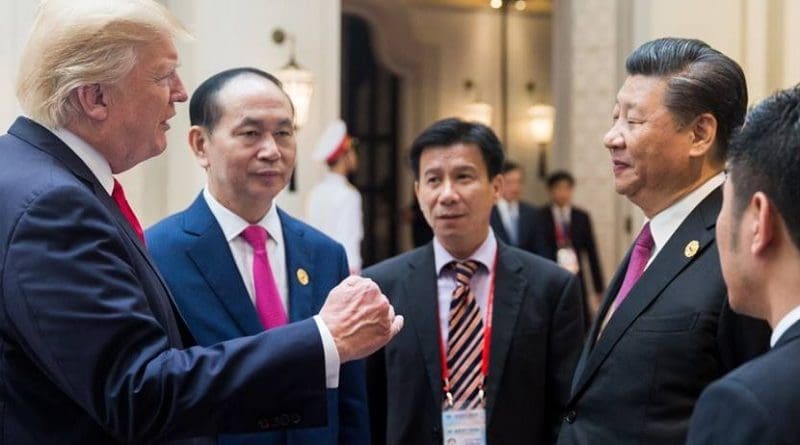China’s Approach To US Trade War Fundamentally Flawed – OpEd
By Arab News
By Dr. John C. Hulsman*
At its best, political risk analysis is about stripping complex geopolitical problems down to their essence for businesses and investors, going beyond the basic day-to-day narratives of the press and finding the key drivers that determine international outcomes. Done well, this provides the corporate community with a tremendous advantage in understanding (and then acting on this comprehension) the beguiling new era we find ourselves in.
Presently, such analytical clarity is needed nowhere more than in making sense of the highly complex trade war that has sprung up between China and the US. The myriad weapons of the trade war — tariffs, currency depreciations, state aid for afflicted industrial sectors — are all commented on ritually, and with depressing similarity, in hundreds of daily publications.
Yet, while the foreground is obviously necessary, it does not really get us anywhere. What is needed, and far harder to accomplish, is to see the underlying, primary calculations that are driving both sides, and what they portend for the near future.
The basic problem here is that the trade war is thought of superficially as about economics, while the present primary driver for the conflict is undoubtedly one political calculation that is common to both sides: That of the 2020 US presidential elections. In other words, the trade war is now far more about politics than economics. If we are to go through the looking glass and make sense of this present primary cause of global political risk, we must start with this counterintuitive reality.
Once it became clear that President Donald Trump was not about to accept the initial spring 2018 Chinese gambit to settle the impending trade war, Beijing’s calculations have increasingly centered around waiting out the recalcitrant, unpredictable president.
The White House spurned Beijing’s offer of purchasing billions more in US agricultural products to superficially offset the bilateral trade deficit, all the while doing little to change the basic structural controversies between the two (intellectual property theft, forced technology transfers, and China not opening its high-tech market nearly so much as the West has done).
Trump has shown himself to be an awkward customer for the Chinese leadership; so better to stall real negotiations until after the 2020 elections in the hope the volatile administration will be thrown out of office.
Initial polling numbers would seem to bolster this crucial Chinese political calculation. The president has not enjoyed even one day of his tenure with the support of the majority of the American people. In recent head-to-head polling, he finds himself behind such leading Democratic presidential candidates as former Vice President Joe Biden and Sens. Elizabeth Warren and Kamala Harris. On the surface, it would seem a good analytical bet to try to wait out a trade war with a White House this politically vulnerable.
But President Xi Jinping’s political risk calculation is fundamentally flawed on several fronts. First, the same 2020 presidential political imperative is driving Trump to also dig in his heels over the trade dispute negotiations. Strikingly, in an increasingly toxic Washington, one of the few things implacable Democratic and Republican foes can agree on is that the US must take a fundamentally tougher strategic line with China. This common, bipartisan feeling is the greatest foreign policy sea change made over the past decade in the capital. Everyone is now a China hawk.
Trump is well aware of this. It was no less an arch-foe than Senate Minority Leader Chuck Schumer who urged the president very publicly to stand firm in negotiating with Beijing. Indeed, pre-Trump, it was the traditionally more protectionist Democrats — those worried about China undermining American wages and flouting international environmental standards — that first adopted the anti-China position that now flourishes in both parties.
So, for Trump, all the political risk incentives flow in one direction; the tougher he is on China, the safer he is both with his political base as well as the few Democratic moderates who might just support him. Even more importantly, if he were to cave in and accept a superficial deal, such as the Chinese proposed in the spring of 2018, his Democratic foes would have a very large policy stick to beat him with in a country that is increasingly united in seeing China as its new global competitor.
And it is over this last point that Xi and the rest of the Chinese leadership have rather spectacularly miscalculated. For waiting out Trump will not solve what ails the Sino-American relationship, or even quietly put an end to the trade war. Even if a Democrat prevails over Trump (a scenario I find highly unlikely), they will continue with his hard line over both China and trade.
The Chinese leadership has failed to note that, dramatically and quickly, bipartisan support has coalesced around the basic proposition that China and America are entering a new Cold War and that, after decades of wishful thinking that China would emerge as a status quo power upholding the American-centric world, instead it has emerged as a revolutionary power determined to upend it. In the end, Trump is not the problem for Xi; America is the problem.
- Dr. John C. Hulsman is the president and managing partner of John C. Hulsman Enterprises, a prominent global political risk consulting firm. He is also senior columnist for City AM, the newspaper of the City of London. He can be contacted via https://www.chartwellspeakers.com.

